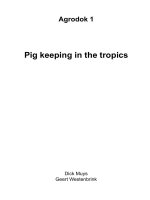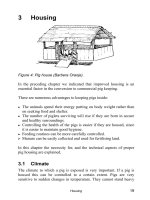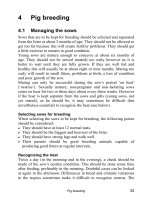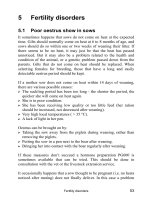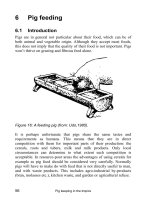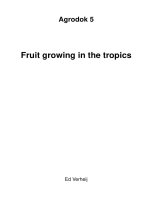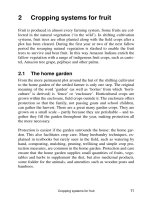Fruit growing in the tropics - Part 5 docx
Bạn đang xem bản rút gọn của tài liệu. Xem và tải ngay bản đầy đủ của tài liệu tại đây (42.89 KB, 6 trang )
Training: pruning and bending
41
5 Training: pruning and bending
5.1 Definition; the limited role of pruning in
tropical fruits
Pruning is the removal of unwanted
growth in order to stimulate desired
growth: something is removed to obtain
a certain response. It follows that you
cannot judge pruning solely by the
looks of the tree immediately after
pruning or by the amount of cut wood
lying under the tree. The quality of
pruning can only be judged after the
plant has had time (say: a growing sea-
son) to respond.
With experience you can predict the
response to some extent. However,
growing conditions modify the tree’s
response to pruning. If tree vigour is
moderate and the tree is going to bear a
good crop the response is more predict-
able. Weak or excessively vigorous
growth and failure to bear make the re-
sponse to pruning more erratic. Experi-
ments (for instance in citrus) usually
show yield reductions following prun-
ing, and no clear-cut advantages.
A shoot or branch can be placed in the desired position by bending.
This is an attractive alternative to pruning, particularly for young trees
that still have to fill the allotted space. The trend to replace pruning to
some extent by bending has led to a much more rapid increase in
cropping volume, for instance in tea (‘pegging down’) and apple (fig-
ure 10). Training is a combination of bending and pruning.
Figure 10: Bending down
vigorous shoots that com-
pete with the leading
shoot.
Fruit growing in the tropics
42
Vines have to be trained on a supporting trellis. The cheapest way is to
use live posts for a vertical trellis (e.g. for pitahaya), a T-shape trellis
(e.g. for passionfruit) or an overhead pergola (for grape). The over-
head structure can consist of bamboo crossbars that support the wires.
Agrodok 19: Agroforestry, lists tree species that can be trained as live
posts.
People often think that pruning is needed for trees that grow too vig-
orously. This may be true for young trees, but bending vigorous shoots
or imposing stress (as explained in Chapter 6) is usually a better solu-
tion. However, bearing trees in fact need to be pruned when shoot
growth has been weakened by heavy fruit loads, to the extent that (the
quality of) the next crop is endangered. By setting back flower-
ing/fruiting, pruning restores tree vigour and enables the tree to pro-
duce another high-quality crop.
First heavy crops, then pruning
A useful rule of thumb is: pruning encourages renewed growth at the expense
of flowering/fruiting. Thus there is not much scope for pruning until the yield
levels of tropical fruit are greatly improved.
How much new shoot growth is generated by pruning and how flow-
ering and fruiting are affected depends mainly on which portion of the
shoot or branch is cut.
5.2 Cutting increasingly large portions of a
shoot/branch
According to where the shoot, twig or branch is cut, pruning can be
classified as follows (figure 11):
? Tipping or pinching: removal of the shoot tip;
? Cutting back: removal of a substantial portion of the shoot;
? Stubbing: cutting near the point of attachment of the shoot, leaving
only a stub;
? Cutting out or thinning: removing the entire shoot by a cut at the
point of attachment.
Training: pruning and bending
43
Figure 11: Growth response to cutting increasing portions of a twig
Tipping
Tipping, usually called pinching when done with the fingernails,
sounds like the most delicate of pruning methods, but the response is
dramatic. Many buds in the leaf axils below the cut sprout and grow
into (fairly weak) shoots. The result is a sharp increase in branching,
as you can see from the reaction of tea to harvesting and that of
hedges to trimming. An important side effect is that flowering is sup-
pressed: plucked tea bushes and regularly trimmed hedges do not
flower at all. Hormones produced in the shoot tip inhibit sprouting of
the buds in the leaf axils; that is why the response to removal of the
shoot tip is so strong.
When the vigorous shoots of a young grape are trained along the wire
to form the permanent arms, repeated tipping ensures that side shoots
emerge in virtually every leaf axil of these shoots. This is necessary
because the side shoots later become the spurs that will bear the fruit-
ing canes. Excellent growing conditions (generous manuring, timely
watering) are of course needed to sustain the growth of the main arms
and to support the growth of all these side shoots.
Fruit growing in the tropics
44
Figure 12: Shoot growth following cutting back (left), in comparison
with shoot growth of an unpruned tree (right)
Cutting back
When more wood is removed than just the shoot tip the treatment is
called cutting back. The response changes as a larger portion of the
shoot is cut: fewer side shoots grow out and they are more vigorous,
especially the uppermost ones. The latter grow at a small angle with
the branch; further down the angle gets wider as the shoots get weaker
(see figure 11). Vigorous growth of the shoot tip in young unbranched
trees means a strong flow of hormones inhibiting side shoots. Cutting
back, either in the nursery or after planting, is the way to ensure
branching of maiden trees at the desired height (see figure 12); note
that the leading shoot in figure 10 has also been cut back. Cutting back
is also practiced on so-called whips, very vigorous unbranched shoots,
in young annona and plum trees. Again the objective is to force the
whips to form short side shoots that are more likely to bear fruit, as
shown in figure 13.
Training: pruning and bending
45
Stubbing
Stubbing is making a drastic cut,
leaving only a stub of the shoot or
limb. The general response is the
growth of several shoots of near-
equal vigour. The reason is that on
the stub only underdeveloped,
dormant buds are present. It takes
a bit longer for these buds to
sprout and there is no dominance
of the uppermost bud. Stubbing is
the way to prune ornamental
shrubs, such as hibiscus, since
growth of a number of equivalent
shoots is exactly what is needed.
Sometimes trees are drastically
rejuvenated through stubbing
(also called stumping), e.g. cof-
fee, citrus, peach. In that case,
thinning is needed to leave only
the required number of shoots for
the new framework.
Cutting out
Cutting out or thinning is the removal of complete shoots or branches.
This is the most drastic cut, yet the response of the tree is rather mild.
Often there is no renewed growth at all near the cut, the response is
dispersed over the rest of the tree. Because of its obvious direct effect
and the moderate reaction of the tree, THINNING IS THE PRINCIPAL
PRUNING METHOD. You can see immediately what you have done
and need not worry too much about the after-effects.
Hand the shears to an untrained person and he will start cutting back,
shortening shoots and branches. He neither wants to cut too much nor
too little, but in fact he is maltreating the tree. Cutting back leads to
compensatory growth and stimulates branching; whereas tipping tends
Figure 13: Fruiting side shoots
on a sugarapple whip that was
cut back
Fruit growing in the tropics
46
to suppress flowering completely, cutting back greatly reduces flower-
ing. Apart from the examples of maiden trees and whips given above,
there is little scope for cutting back in fruit growing. Bad experiences
with pruning of tropical fruit trees are based in part on this cut, while
the alternative, cutting out, is often overlooked.
Cutting out is the way to relieve overcrowding in the tree crown. Tell-
tale signs are inferior fruit quality, poor flowering and fruit set, or
early leaf fall in the interior of the canopy. (If the trees are too close
together, some should be uprooted because pruning cannot solve this
problem.) Thinning is also practiced in the case of excessive flowering
(coffee: cut out some plagiotropic shoots) or excessive fruit set (citrus:
cut out some twigs with large numbers of fruitlets) to maintain the
vitality of the tree.
Removal of ageing, sagging branches to the point where a younger
shoot emerges (usually where the branch bends downwards) is a
common form of thinning in apple, pear and plum. It is a way of reju-
venating the fruiting wood to prevent a decline in fruit quality. Exam-
ples of cutting out in young trees include the removal of upright
branches in durians which will dominate the feathery horizontal
branches (See figure 5) and, in the year after planting, the brushing off
of side shoots emerging too low on the trunk to become permanent
limbs (see Chapter 10).
5.3 Summary
Training of trees and vines consists of pruning and bending. Bending
reduces the need for pruning, thus enabling young trees to expand
more quickly. Pruning plays a modest role in the tropics because it
stimulates compensatory growth of shoots at the expense of fruiting;
this is seldom necessary because most crops are shy bearers. Bad ex-
periences with pruning are partly due to the common practice of cut-
ting back. If bearing trees require pruning, this should nearly always
be cutting out (thinning).


